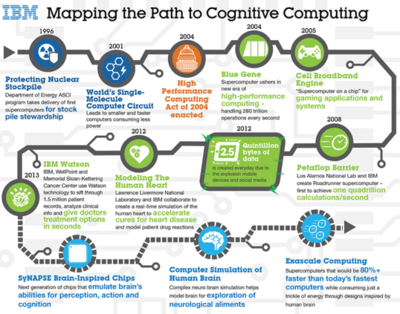Difference between revisions of "Cognitive Computing"
(Created page with "'''Cognitive Computing (CC)''' is the simulation of human thought processes in a computer model. It is a technology platform based on the scientific disciplines of artificial...") |
|||
| Line 1: | Line 1: | ||
| − | '''Cognitive Computing (CC)''' is the simulation of human thought processes in a computer model. It is a technology platform based on the scientific disciplines of artificial intelligence and signal processing. In summary, a cognitive computer ploughs through un/structured data, to find hidden knowledge and present data in an actionable form. It is worth noting that CC is an iterative process, with humans verifying or discarding any new discoveries. This allows the system to ‘learn’ over time, and become better at identifying patterns.<ref>Definition - What Does Cognitive Computing mean? [https://mse238blog.stanford.edu/2017/07/jgokani/cognitive-computing/ Stanford.edu]</ref> | + | '''Cognitive Computing (CC)''' is the simulation of human thought processes in a computer model. It is a technology platform based on the scientific disciplines of [[Artificial Intelligence (AI)|artificial intelligence]] and [[Signal Processing|signal processing]]. In summary, a cognitive computer ploughs through un/structured data, to find hidden knowledge and present [[Data|data]] in an actionable form. It is worth noting that CC is an iterative process, with humans verifying or discarding any new discoveries. This allows the system to ‘learn’ over time, and become better at identifying patterns.<ref>Definition - What Does Cognitive Computing mean? [https://mse238blog.stanford.edu/2017/07/jgokani/cognitive-computing/ Stanford.edu]</ref> |
| − | Looking back at the origin of Cognitive computing, it was first mentioned by Alan Turing in 1950, through his ‘Computing Machinery and Intelligence’ paper. He proposed the Turing Test, to assess a machine’s ability to exhibit intelligent human behavior. The science behind | + | Looking back at the origin of Cognitive computing, it was first mentioned by Alan Turing in 1950, through his ‘Computing Machinery and Intelligence’ paper. He proposed the Turing Test, to assess a machine’s ability to exhibit intelligent human behavior. The science behind cognitive computing has only recently gained momentum, with advancements made within fields such as data mining and natural language processing. The graph below shows a timeline of the progression of Cognitive computing: |
[[File:Path of Cognitive Computing.png|400px|Mapping the Path to Cognitive Computing.png]]<br /> | [[File:Path of Cognitive Computing.png|400px|Mapping the Path to Cognitive Computing.png]]<br /> | ||
source: Stanford University | source: Stanford University | ||
| + | |||
| + | |||
| + | == Cognitive Computing Vs. AI<ref>The Distinction Between Cognitive Computing and AI [https://www.intelligentautomation.network/artificial-intelligence/articles/a-basic-guide-to-cognitive-computing Intelligent Automation Network]</ref> == | ||
| + | Artificial intelligence and cognitive computing work from the same building blocks, but cognitive computing adds a human element to the results. AI is a number cruncher, concerned with receiving large amounts of data, learning from the data, finding patterns in that data, and delivering solutions from that data. Cognitive computing, on the other hand, takes those outputs and examines their nuances. | ||
| + | |||
| + | For example, Google Maps and Fitbit use [[Big Data|big data]], [[Machine Learning|machine learning]], and [[Predictive Analytics|predictive analytics]] in their problem solving methods. Siri, Alexa, Watson, and company-specific chatbots do as well, but they can receive and deliver [[Information|information]] naturally, leveraging both structured and unstructured data. These products are AI technologies embodied with human-like names and personalities. | ||
Revision as of 13:48, 27 October 2021
Cognitive Computing (CC) is the simulation of human thought processes in a computer model. It is a technology platform based on the scientific disciplines of artificial intelligence and signal processing. In summary, a cognitive computer ploughs through un/structured data, to find hidden knowledge and present data in an actionable form. It is worth noting that CC is an iterative process, with humans verifying or discarding any new discoveries. This allows the system to ‘learn’ over time, and become better at identifying patterns.[1]
Looking back at the origin of Cognitive computing, it was first mentioned by Alan Turing in 1950, through his ‘Computing Machinery and Intelligence’ paper. He proposed the Turing Test, to assess a machine’s ability to exhibit intelligent human behavior. The science behind cognitive computing has only recently gained momentum, with advancements made within fields such as data mining and natural language processing. The graph below shows a timeline of the progression of Cognitive computing:
Cognitive Computing Vs. AI[2]
Artificial intelligence and cognitive computing work from the same building blocks, but cognitive computing adds a human element to the results. AI is a number cruncher, concerned with receiving large amounts of data, learning from the data, finding patterns in that data, and delivering solutions from that data. Cognitive computing, on the other hand, takes those outputs and examines their nuances.
For example, Google Maps and Fitbit use big data, machine learning, and predictive analytics in their problem solving methods. Siri, Alexa, Watson, and company-specific chatbots do as well, but they can receive and deliver information naturally, leveraging both structured and unstructured data. These products are AI technologies embodied with human-like names and personalities.
- ↑ Definition - What Does Cognitive Computing mean? Stanford.edu
- ↑ The Distinction Between Cognitive Computing and AI Intelligent Automation Network

